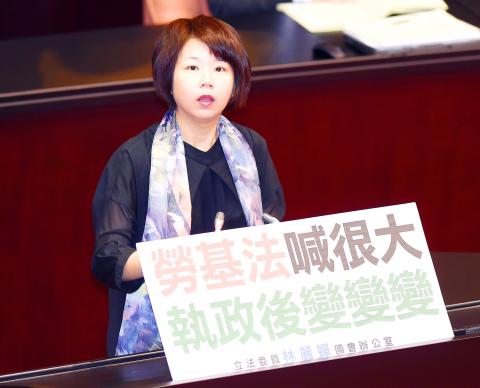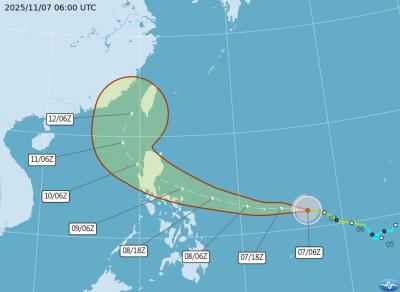The Ministry of Labor’s draft amendments to the Labor Standards Act (勞動基準法) have drawn criticism within the governing party, with several Democratic Progressive Party (DPP) lawmakers publicly challenging the proposals.
During a legislative question-and-answer session on Thursday, DPP Legislator Chung Kung-chao (鍾孔炤), a former labor rights activist, put up a placard reading “dumbfounded by tremendous sadness” and stood behind the podium in silence for six minutes until his time was up when it was his turn to question officials about the proposed amendments,.
The placard depicted a government official nodding “yes” to a fat man sitting on a big sack of money, while shaking his head “no” to a group of protesters demanding dignity for workers.

Photo: Liao Chen-huei, Taipei Times
The fat man is playing with blocks, building a castle with beams and pillars reading “low pay,” “overwork,” “cheap land and utilities” and a pinnacle labeled “subsidies.”
Officials who had worked on the proposed amendments, including Chung’s former colleague at the Taiwan Labour Front, Deputy Minister of Labor Liao Huei-fang (廖蕙芳), looked on in dismay.
Chung’s office issued a statement saying that her move was meant to portray ordinary workers who have been deprived of their voice by their employers, as they do not have a say in the proposed amendments.
DPP Legislator Lin Shu-fen (林淑芬) also panned the draft amendments, calling them ludicrous.
According to the proposed amendments, companies that want to increase employees’ monthly overtime quota from 46 to 54 hours; reduce their rest time between shifts from 11 to eight hours or make them work 12 days in a row by moving days off may do so after gaining the consent of unions or employees through negotiations.
The legal stipulations are flawed, as negotiations between employers and employees, a tier-seven legal tool, should not override a tier-two act, Lin said.
“Deputy Minister Liao, you come from a legal background. Please do not be ridiculous,” Lin said.
Lin said that there are more than 1 million companies nationwide, but only about 70,000 have held meetings with their employees, citing her own research.
In addition, conclusions reached during such meetings are often falsified, and regulations following from such meetings are often rigid and in some cases have not been amended for decades, she said.
Lin was equally dismissive of the proposal to allow workers to be made to work 12 days in a row, saying that as a lawmaker paid handsomely by taxpayers, she could probably live with the “12 on, two off” schedule for several months.
“But if you would want me to adhere to such a schedule for 10 or 20 years, and forgo my family life and time to meet my friends, do you think I could accept that?” Lin asked.
The proposed amendments are overly generous to employers, as even the Taipei-based Chinese National Federation of Industries has asked for increased flexibility in select sectors, such as transportation and nursing, rather than indiscriminate easing of working hour restrictions across the spectrum, she said.
DPP Legislator Chiang Yung-chang (江永昌) said that despite President Tsai Ing-wen’s (蔡英文) policy of encouraging workers to form unions, progress has been slow since the DPP administration took office on May 20 last year.
Less than 7 percent of workers are protected by unions, making employees vulnerable considering the way the amendments have been drafted, Chiang said.

The Central Weather Administration (CWA) today issued a sea warning for Typhoon Fung-wong effective from 5:30pm, while local governments canceled school and work for tomorrow. A land warning is expected to be issued tomorrow morning before it is expected to make landfall on Wednesday, the agency said. Taoyuan, and well as Yilan, Hualien and Penghu counties canceled work and school for tomorrow, as well as mountainous district of Taipei and New Taipei City. For updated information on closures, please visit the Directorate-General of Personnel Administration Web site. As of 5pm today, Fung-wong was about 490km south-southwest of Oluanpi (鵝鑾鼻), Taiwan's southernmost point.

Tropical Storm Fung-Wong would likely strengthen into a typhoon later today as it continues moving westward across the Pacific before heading in Taiwan’s direction next week, the Central Weather Administration (CWA) said. As of 8am, Fung-Wong was about 2,190km east-southeast of Cape Oluanpi (鵝鑾鼻), Taiwan’s southernmost point, moving westward at 25kph and possibly accelerating to 31kph, CWA data showed. The tropical storm is currently over waters east of the Philippines and still far from Taiwan, CWA forecaster Tseng Chao-cheng (曾昭誠) said, adding that it could likely strengthen into a typhoon later in the day. It is forecast to reach the South China Sea

Almost a quarter of volunteer soldiers who signed up from 2021 to last year have sought early discharge, the Legislative Yuan’s Budget Center said in a report. The report said that 12,884 of 52,674 people who volunteered in the period had sought an early exit from the military, returning NT$895.96 million (US$28.86 million) to the government. In 2021, there was a 105.34 percent rise in the volunteer recruitment rate, but the number has steadily declined since then, missing recruitment targets, the Chinese-language United Daily News said, citing the report. In 2021, only 521 volunteers dropped out of the military, the report said, citing

Nearly 5 million people have signed up to receive the government’s NT$10,000 (US$322) universal cash handout since registration opened on Wednesday last week, with deposits expected to begin tomorrow, the Ministry of Finance said yesterday. After a staggered sign-up last week — based on the final digit of the applicant’s national ID or Alien Resident Certificate number — online registration is open to all eligible Taiwanese nationals, foreign permanent residents and spouses of Taiwanese nationals. Banks are expected to start issuing deposits from 6pm today, the ministry said. Those who completed registration by yesterday are expected to receive their NT$10,000 tomorrow, National Treasury